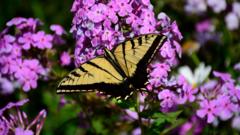Research by Binghamton University indicates that butterfly populations in the US have decreased by 22% from 2000 to 2020, with 33% of species facing serious threats. Factors like habitat loss, pesticides, and climate change contribute to this alarming trend, particularly in the Southwest. However, experts suggest that recovery is possible with targeted conservation measures.
US Butterfly Populations Decline by Over 20% in 20 Years, Urgent Conservation Needed

US Butterfly Populations Decline by Over 20% in 20 Years, Urgent Conservation Needed
A new study reveals significant declines in butterfly populations across the United States, highlighting the need for immediate conservation efforts to combat habitat loss and climate change impacts.
Butterfly populations in the United States have seen a startling decline, with more than 20% lost over the last two decades, according to a study conducted by Binghamton University in New York. From 2000 to 2020, the research indicates a 22% reduction in butterfly numbers, with a concerning one-third of species experiencing significant declines.
The study, published in the journal Science, analyzed 12.6 million sightings from 76,000 surveys across 35 different monitoring programs, including citizen science initiatives like the North American Butterfly Association's July counts. Using sophisticated statistical models, researchers estimated population trends for a total of 342 butterfly species, revealing that 33% are in serious decline. Among them, 107 species experienced population reductions of over 50%, with notable cases such as Julia's Skipper, which has lost more than 90% of its numbers.
Several butterfly species, such as the Florida white, Hermes copper, tailed orange, Mitchell's satyr, and West Virginia white, have plummeted in abundance by more than 98%. The West Coast lady, a formerly common species, has dropped by 80%, highlighting the vulnerability of even adaptable butterflies.
Professor Eliza Grames, an assistant professor of biological sciences at Binghamton University, stated, "While the results aligned with global trends, seeing the extent of the decline at such a large spatial scale was sobering." The study emphasizes that habitat loss, pesticide use, and climate change are major contributors to these declines, making butterflies' role as pollinators all the more crucial for supporting plant and crop life.
Particularly hard-hit is the Southwest region of the United States, where extreme drought conditions are believed to directly harm butterfly populations and their food sources. "Drought is a double threat—it harms butterflies directly and also affects their food and host plants," Professor Grames elaborated.
The research findings could lead to impactful conservation initiatives, including prioritizing butterfly species for the International Union for Conservation of Nature (IUCN) Red List of Threatened Species and seeking protections under the Endangered Species Act. Despite the concerning trends, there is optimism regarding recovery; butterflies can rebound relatively quickly due to their short life cycles.
Professor Grames highlighted practical actions individuals can take, such as planting wildflowers, reducing pesticide usage, and leaving portions of yards unmowed to create better habitats for butterflies. She also called for governmental support, saying, "Insects are fundamental to life on earth, and we need conservation actions and policies that support insects."





















